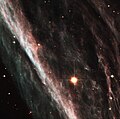Fájl:Pencil hst big.jpg

Az előnézet mérete: 606 × 599 képpont További felbontások: 243 × 240 képpont | 485 × 480 képpont | 777 × 768 képpont | 1 036 × 1 024 képpont | 2 071 × 2 048 képpont | 3 289 × 3 252 képpont.
Eredeti fájl (3 289 × 3 252 képpont, fájlméret: 10,13 MB, MIME-típus: image/jpeg)
Fájltörténet
Kattints egy időpontra, hogy a fájl akkori állapotát láthasd.
| Dátum/idő | Bélyegkép | Felbontás | Feltöltő | Megjegyzés | |
|---|---|---|---|---|---|
| aktuális | 2006. szeptember 19., 00:38 |  | 3 289 × 3 252 (10,13 MB) | WilliamKF | {{Information| |Description=From the NASA press release: :Remnants from a star that exploded thousands of years ago created a celestial abstract portrait, as captured in this NASA Hubble Space Telescope image of the Pencil Nebula. :Officially known as N |
Fájlhasználat
Az alábbi lap használja ezt a fájlt:
Globális fájlhasználat
A következő wikik használják ezt a fájlt:
- Használata itt: ar.wiki.x.io
- Használata itt: ast.wiki.x.io
- Használata itt: az.wiki.x.io
- Használata itt: be.wiki.x.io
- Használata itt: cs.wiki.x.io
- Használata itt: de.wiki.x.io
- Használata itt: en.wiki.x.io
- Használata itt: en.wikiquote.org
- Használata itt: eo.wiki.x.io
- Használata itt: es.wiki.x.io
- Használata itt: fr.wiki.x.io
- Használata itt: hr.wiki.x.io
- Használata itt: it.wiki.x.io
- Használata itt: kk.wiki.x.io
- Használata itt: ko.wiki.x.io
- Használata itt: lb.wiki.x.io
- Használata itt: mk.wiki.x.io
- Használata itt: pl.wiki.x.io
- Használata itt: pt.wiki.x.io
- Használata itt: ro.wiki.x.io
- Használata itt: ru.wiki.x.io
- Használata itt: sk.wiki.x.io
- Használata itt: sr.wiki.x.io
- Használata itt: sv.wiki.x.io
- Használata itt: tr.wiki.x.io
- Használata itt: tr.wikiquote.org
- Használata itt: uk.wiki.x.io
- Használata itt: uz.wiki.x.io
- Használata itt: vi.wiki.x.io
- Használata itt: zh.wiki.x.io